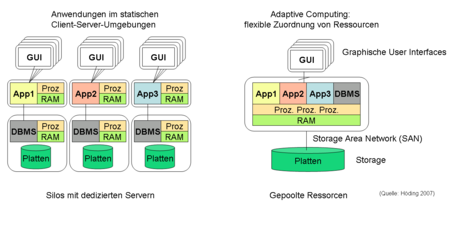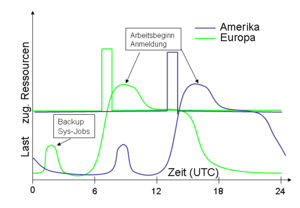Adaptive Computing
Adaptive Computing is a concept for the flexible allocation of resources (processor, main memory, secondary memory) to services and applications in data center environments. The aim is to use existing hardware resources as required and in this way to reduce costs. The management of IT infrastructures should also be simplified in this way.
From static client-server structures to adaptive computing
Traditional IT infrastructure, disadvantages
Larger companies usually operate several servers on which different systems support the company's operational processes. This includes ERP systems for the integration of production, finance, etc., planning systems or data warehouse systems. In the application service providing environment , in large or globally operating companies or in connection with development infrastructures, more than one system is often operated.
In general, a system is installed on one or more dedicated server computers. This creates installations from a large number of heterogeneous server computers. Causes of heterogeneity are
- Different application requirements: ERP system vs. data warehouse system
- Type of application: Productive system vs. Development system
- Historical causes such as hardware development , purchasing hardware
This makes system operation difficult.
Another disadvantage of static architectures is the low adaptability z. B. at peak loads. In terms of usability, a system must be designed in such a way that it has an acceptable response time behavior even in times of high load. However, systems are rarely used continuously throughout the day. Resources are wasted in times of low activity.
Transition to Adaptive Computing
With adaptive computing, the existing resources are now configured for shared use. The first step is to acquire dedicated hardware for the resource types. The second step is to create pools of resources. In the third step, applications and scenarios are defined that use or assign these pools as required.
Instead of many servers, each with processors, main memory, secondary memory and network, you now have
- an integrated server with a large number of processors and
- a large main memory
- configurable network structures, including storage area networks
- external storage systems, disk arrays
While external storage systems have already been used in connection with rather static client-server installations, the flexible allocation of processor and main memory is a decisive innovation.
Advantage: Saving resources during peak loads
The use of application systems is inconsistent. Typical load peaks result e.g. B. with e-commerce systems (B2C) in the evening hours or in the operational environment as a result of the system login when starting work.
The latter period is often different, not only in the global context (Europe, America), but also in the regional context. Despite the same geographical length, the start of work in Saxony-Anhalt is around an hour earlier than in Munich. Taking advantage of this fact now allows Adaptive Computing. The corresponding found or defined usage pattern is now
- from 7 a.m. to 8 a.m., a larger part of the resources is allocated to the system used in Saxony-Anhalt and
- from 8 a.m. to 9 a.m., a large part of the resources is allocated to Munich.
- From 9 a.m. the resources are distributed equally.
This enables short-term peak loads to be absorbed. In traditional infrastructures, this is only possible through a clever and long-term planned distribution of systems to resources.
Advantage: simplification of the system management
Long-term changes in requirements can also be well covered by adaptive computing with the advantage of shorter implementation times. (In this context, "long-term" should be understood to mean days instead of minutes or hours during peak loads.)
If an additional application system is installed, long-term hardware procurement is not absolutely necessary. This is particularly interesting for evaluation projects. With adaptive computing, resources are allocated flexibly within the framework of the existing architecture. The applications that are already running are marginally affected.
literature
- Ian Parmee: Adaptive Computing in Design and Manufacture V. Springer Verlag, London 2002, ISBN 978-1-85233-605-9 .
- Ian C. Parmee: Evolutionary and Adaptive Computing in Engineering Design. Springer Verlag, London 2001, ISBN 978-1-4471-1061-3 .
- Nadia Nedjah, Chao Wang (Ed.): Reconfigurable and Adaptive Computing. Theory and Applications, Taylor & Francis Group LTC, 2016, ISBN 978-1-4987-3176-8 .
- Anupam Shukla, Ritu Tiwari, Rahul Kala: Towards Hybrid and Adaptive Computing. A Perspective, Springer Verlag, Berlin / Heidelberg 2010, ISBN 978-3-642-14343-4 .
- Ran Chen: Intelligent Computing and Information Science. Springer Verlag, Berlin / Heidelberg 2011, ISBN 978-3-642-18128-3 .
See also
Web links
- An Effective Technique for Adaptive Computing (accessed July 27, 2017)


